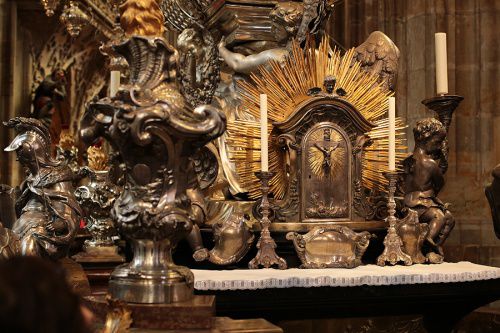When Bishop Robert Morlino arrived as the new bishop for the Diocese of Madison, Wis. in 2003, he began quietly encouraging priests to promote more reverence towards the Blessed Sacrament — through more adoration, more reverent Masses, and moving tabernacles back to the center of churches.
Now, he's made it official. Bishop Morlino has asked his priests to make sure every tabernacle is moved to the center of each church behind the altar by 2018.
“Obviously the reason is because he wants to reiterate that this is the living God residing in the tabernacle,” Patrick Gorman, director of the Office of Worship for the Madison diocese, told CNA.
“This isn't just another piece of furniture which can go anywhere, this is the house of the living God and we want to have that in a prominent place where people can pray before it whenever they want.”
In the wake of Vatican II, many churches in Madison and throughout the United States relocated their tabernacles either to the side of sanctuaries or to their own side chapels. The idea at the time, Gorman said, was that this created a separate, quiet space which would encourage more people to spend time in adoration.
“After Vatican II, (the tabernacle) could be in a sanctuary or separate chapel… it still had to be prominently located, which is where we were finding some of the confusion. Tabernacles were being placed in chapels that weren’t even adjacent to the nave of the church let alone the sanctuary, so that when you walked into the Church proper, there would be none visible,” he said.
“I think that was the first step of the confusion, to say that the Church has these two options, and this is what they're supposed to be. The chapel kind of got divorced from the worship space of the church and kind of got put aside for a separate thing almost.”
There were also some who argued at the time that Christ had two presences in the Eucharist — His presence in the tabernacle and His presence on the altar, and that the separate locations helped emphasize this.
Gorman said it's an argument that few in the Church will make, and that it just ended up contributing to the confusion.
“There's no conflict,” when it comes to Jesus' presence in the Blessed Sacrament, whether on the altar or in the tabernacle, Gorman added.
There are several major Cathedrals and Basilicas — like St. Peter’s in Rome, for example — that maintain separate chapels for tabernacles and Eucharistic adoration, but this is primarily because they are churches that see a lot of visitors and tourists, Gorman said.
For the most part, in Madison, Wisc., that's not the case.
“The average church in a diocese doesn't have visitors coming and going all the time, and certainly in our diocese, even when the new Cathedral is built I suspect there won't be, so there's no need for a side chapel,” he said.
“People can come in and it'll be quiet. Occasionally there might be a run-in with a wedding rehearsal or something, but that’s manageable.”
Even before Bishop Morlino told his priests of the three year plan to move the tabernacles, he had asked several years ago that every new church built in the diocese place the tabernacle in the center behind the altar.
Many priests were also preferring to move tabernacles to the center of their parishes on their own initiative, so it was a direction in which the diocese was already heading, Gorman said.
The bishop has allowed three years for the project because the nature of tabernacles can make them difficult to move — they are supposed to be made of a solid, unbreakable material and securely attached to the church.
Gorman said in most cases, the move should be simple. Most churches have tabernacles already in the sanctuary that may be a little off-center. A few will require a bit more cost and effort.
Overall, Gorman said, the project has been well-received within the diocese among priests and parishioners alike, with many people sending the bishop their thanks on social media.
“I don't know that too many people are crushed by it, and even most of the priests had already done this to be honest…it's somewhat of a non-issue. We were moving that way, the bishop acknowledged that, but he said let’s finish this one up.”
“The idea is we’re going to put Christ in the most central place in the Church because that’s the position he has in the Church, in the body of Christ,” he added. “Of course Jesus Christ himself is in it, therefore standing at the head of our church.”
“That the tabernacle then has its own prominent space at the center of the church is just one more way to show we believe in this presence of Christ and we’re going to follow him wherever he goes.”

